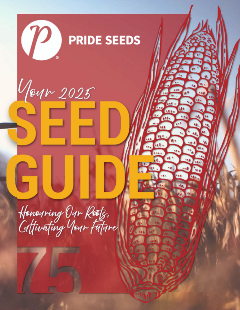Browse our selection of products below
___________________________________________________________________________________________________________________________________________

2024-2025 PRIDE Seeds Product GuideYou can find all of our products on the website, including supporting performance data and create your own personalized guide called My Guide. You can also download the digital version of our printed product guide which includes product comparison charts. |
Enhance your knowledge and stay ahead with PRIDE SEEDS Corn and Soybean School videos.
SHOP THE PRIDE SEEDS E-STORE
-7.png?sfvrsn=87920db3_3)
STAY UP-TO-DATE WITH PRIDE SEEDS LATEST BLOGS, NEWS AND ARTICLES
Goss’s Wilt in Corn
While Goss’s Wilt is found in Western Canada, and while it is not currently widespread and is hard to find in fields year after year, you do need to know how to identify and manage. Yield losses from Goss’s Wilt in corn can be significant with a potential loss upwards of 30-50% if the infection is severe enough and depending on the growth stage the plant is at when disease sets in.
Goss’s Wilt is a bacterial disease that infects corn through an opening or wound in the leaves. These wounds could be caused by hail, wind, insect pressure or another pest. When Goss’s Wilt bacterial are present, it is spread from plant to plant by the movement of water. Wet, warm weather favours the spread of the disease and temperatures about 26C are ideal.
The disease occurs in two phases: Leaf blight and systemic wilt. Goss’s Wilt can be identified by the irregular, water soaked tan lesions as well as a shiny bacterial ooze present on the surface of the leaf.
The bacterium carries over year to year in the residue, so crop rotation is very important for managing the disease. Removing or burying residue through tillage can also aid in reducing infection risk. Because Goss’s Wilt is a bacterial disease, fungicide applications will not slow the spread or cure the disease, and the best management practice is hybrid selection. Planting a hybrid with a high tolerance for the disease reduces the risk and potential loss.
TAKE PRIDE IN YOUR INBOX
Expert advice, news and information
THE PRIDE SEEDS ADVANTAGE
Farming is one of the most demanding industries in the world, subject to a variety of factors such as time, weather, and global pressures. You know this every time you look out the window and think about the field in front of you. Growers and dealers deserve an advantage: The PRIDE Seed Advantage.
LEARN MORETHE PRIDE SEEDS ADVANTAGE
Every year PRIDE Seeds works hard to produce leading-edge products that enable success where it matters most, on your farm. Our dedicated team strives to provide sales expertise, agronomy support, quality production, and service tailored to meet your needs.
LEARN MORE

Leave a commentOrder by
Newest on top Oldest on top